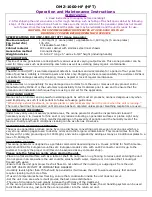
Safety Precautions
4
• that capacitors are discharged: this shall be done in
a safe manner to avoid possibility of sparking;
• that there no live electrical components and wiring
are exposed while charging, recovering or purging
the system;
• that there is continuity of earth bonding.
2.10 Repairs to sealed components
• During repairs to sealed components, all electrical
supplies shall be disconnected from the equipment
being worked upon prior to any removal of sealed
covers, etc. If it is absolutely necessary to have an
electrical supply to equipment during servicing, then
a permanently operating form of leak detection shall
be located at the most critical point to warn of a
potentially hazardous situation.
• Particular attention shall be paid to the following to
ensure that by working on electrical components, the
casing is not altered in such a way that the level of
protection is affected. This shall include damage to
cables, excessive number of connections, terminals
not made to original specification, damage to seals,
incorrect fitting of glands, etc.
• Ensure that apparatus is mounted securely.
• Ensure that seals or sealing materials have not
degraded such that they no longer serve the
purpose of preventing the ingress of flammable
atmospheres. Replacement parts shall be in
accordance with the manufacturer’s specifications.
NOTE: The use of silicon sealant may inhibit the
effectiveness of some types of leak detection equipment.
Intrinsically safe components do not have to be isolated
prior to working on them.
2.11 Repair to intrinsically safe components
• Do not apply any permanent inductive or capacitance
loads to the circuit without ensuring that this will not
exceed the permissible voltage and current permitted
for the equipment in use. Intrinsically safe components
are the only types that can be worked on while live
in the presence of a flammable atmosphere. The test
apparatus shall be at the correct rating.
• Replace components only with parts specified by the
manufacturer. Other parts may result in the ignition of
refrigerant in the atmosphere from a leak.
2.12 Cabling
• Check that cabling will not be subject to wear,
corrosion, excessive pressure, vibration, sharp edges
or any other adverse environmental effects. The check
shall also take into account the effects of aging or
continual vibration from sources such as compressors
or fans.
2.13 Detection of flammable refrigerants
• Under no circumstances shall potential sources of
ignition be used in the searching for or detection of
refrigerant leaks. A halide torch (or any other detector
using a naked flame) shall not be used.
2.14 Leak detection methods
• The following leak detection methods are deemed
acceptable for systems containing flammable
refrigerants. Electronic leak detectors shall be used
to detect flammable refrigerants, but the sensitivity
may not be adequate, or may need re-calibration.
(Detection equipment shall be calibrated in a
refrigerant-free area.) Ensure that the detector is not
a potential source of ignition and is suitable for the
refrigerant used. Leak detection equipment shall be
set at a percentage of the LFL of the refrigerant and
shall be calibrated to the refrigerant employed and
the appropriate percentage of gas (25 % maximum)
is confirmed. Leak detection fluids are suitable for
use with most refrigerants but the use of detergents
containing chlorine shall be avoided as the chlorine
may react with the refrigerant and corrode the copper
pipe-work.
• If a leak is suspected, all naked flames shall be
removed or extinguished.
• If a leakage of refrigerant is found which requires
brazing, all of the refrigerant shall be recovered
from the system, or isolated (by means of shut off
valves) in a part of the systemremote from the leak.
Oxygen free nitrogen (OFN) shall then be purged
through the system both before and during the
brazing process.
2.15 Removal and evacuation
• When breaking into the refrigerant circuit to make
repairs or for any other purpose, conventional
procedures shall be used. However, it is important
that best practice is followed since flammability is a
consideration.
• The following procedure shall be adhered to:
• remove refrigerant;
• purge the circuit with inert gas;
• evacuate;
• purge again with inert gas;
• open the circuit by cutting or brazing.
Summary of Contents for DIY-MULTI2-18HP230C
Page 1: ...4TH GENERATION MULTI ZONE SERVICE MANUAL...
Page 2: ......
Page 5: ......
Page 6: ...Contents 1 Precautions 2 2 Information servicing For flammable materials 3 Safety Precautions...
Page 20: ...5 8...
Page 21: ......
Page 22: ......
Page 24: ...Outdoor unit printed circuit board diagram 17122000051368...
Page 27: ...Outdoor unit printed circuit board diagram 17122300001076...
Page 29: ...Outdoor unit IPM board diagram 17122000018251...
Page 31: ...Outdoor unit printed circuit board diagram 17122000037804...
Page 33: ...Outdoor unit IPM board diagram 17122000042012...
Page 42: ...Outdoor Unit Disassembly 3 2 Dimension 2 1 Panel Plate B30 1 drive 2...
Page 43: ...Outdoor Unit Disassembly 4 2 2 Panel Plate CA30 1 drive 2 1 drive 3 1 drive 4...
Page 44: ...Outdoor Unit Disassembly 5 2 3 Panel Plate CA30 1 drive 2 for US models...
Page 45: ...Outdoor Unit Disassembly 6 2 4 Panel Plate D30 1 drive 2 1 drive 3 1 drive 4 1 drive 5...
Page 46: ...Outdoor Unit Disassembly 7 2 5 Panel Plate D30 1 drive 3 1 drive 4 for US models...
Page 47: ...Outdoor Unit Disassembly 8 2 6 Panel Plate X330 1 drive 2...
Page 48: ...Outdoor Unit Disassembly 9 2 7 Panel Plate X430 1 drive 3...
Page 49: ...Outdoor Unit Disassembly 10 2 8 Panel Plate X430 1 drive 2 for US models...
Page 50: ...Outdoor Unit Disassembly 11 2 6 Panel Plate E30 1 drive 5 for US models...










































